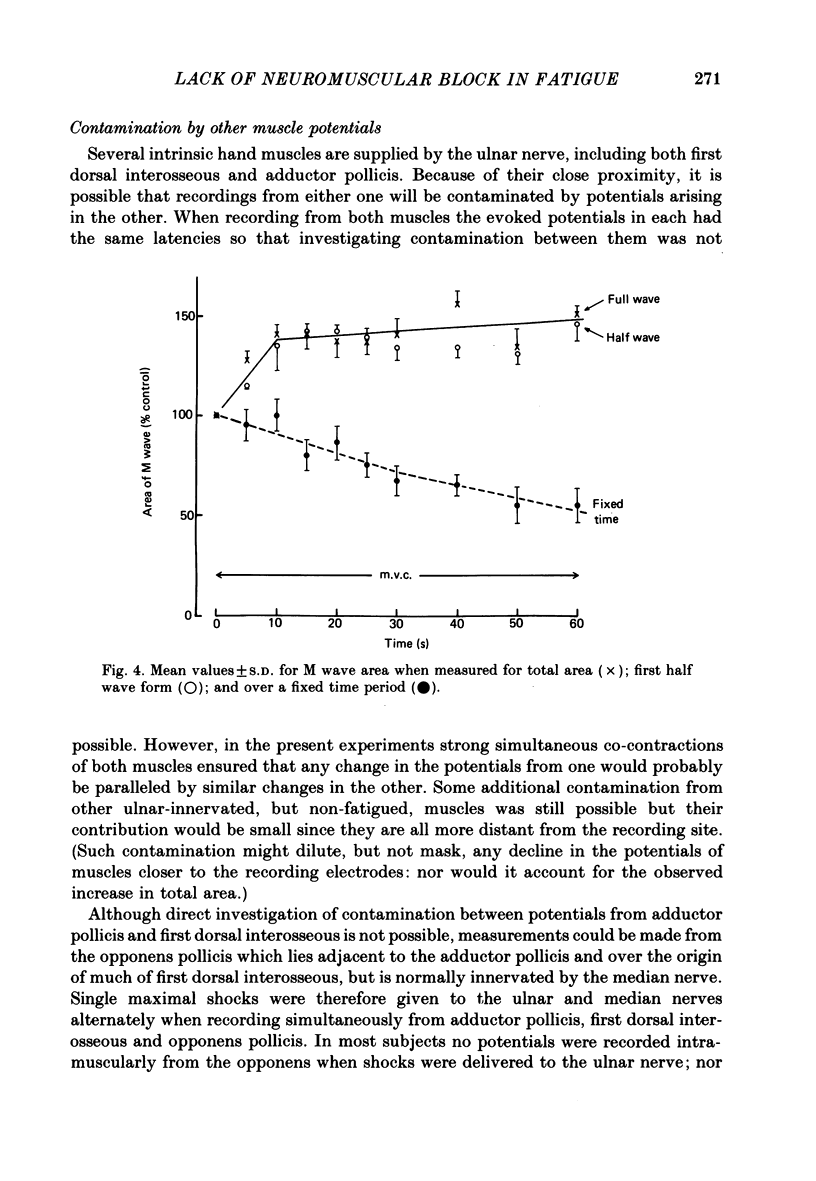Abstract
1. Muscle mass action potentials (M waves) were evoked by supramaximal single shocks to the ulnar nerve given at 5-10 s intervals throughout sustained isometric maximal voluntary contractions (m.v.c.) of the adductor pollicis and first dorsal interosseous muscles. Both muscles were fatigued simultaneously. Recordings were made from the muscle surface and also intramuscularly. 2. During a maximal contraction lasting for 60 s there was 30-50% loss of force. No decline was observed in intramuscularly recorded M wave amplitude, while the areas of the total and half M wave forms increased due to a slowing in conduction velocity. The area measured over a fixed time period declined. No evidence was obtained that these M wave potentials were contaminated by electrical activity arising in adjacent muscles. The size of the single unit potentials appeared to remain unaltered during maximal voluntary activity. 3. We conclude that neuromuscular block is not a cause of force loss during this type of fatiguing voluntary contraction.
Full text
PDF













Selected References
These references are in PubMed. This may not be the complete list of references from this article.
- BIGLAND B., LIPPOLD O. C. Motor unit activity in the voluntary contraction of human muscle. J Physiol. 1954 Aug 27;125(2):322–335. doi: 10.1113/jphysiol.1954.sp005161. [DOI] [PMC free article] [PubMed] [Google Scholar]
- Bigland-Ritchie B., Hosking G. P., Jones D. A. The site of fatigue in sustained maximal contractions of the quadriceps muscle. J Physiol. 1975 Aug;250(1):45P–46P. [PubMed] [Google Scholar]
- Bigland-Ritchie B., Jones D. A., Hosking G. P., Edwards R. H. Central and peripheral fatigue in sustained maximum voluntary contractions of human quadriceps muscle. Clin Sci Mol Med. 1978 Jun;54(6):609–614. doi: 10.1042/cs0540609. [DOI] [PubMed] [Google Scholar]
- Bigland-Ritchie B., Jones D. A., Woods J. J. Excitation frequency and muscle fatigue: electrical responses during human voluntary and stimulated contractions. Exp Neurol. 1979 May;64(2):414–427. doi: 10.1016/0014-4886(79)90280-2. [DOI] [PubMed] [Google Scholar]
- Bigland-Ritchie B., Lippold O. C. Changes in muscle activation during prolonged maximal voluntary contractions [proceedings]. J Physiol. 1979 Jul;292:14P–15P. [PubMed] [Google Scholar]
- Desmedt J. E., Godaux E. Ballistic contractions in man: characteristic recruitment pattern of single motor units of the tibialis anterior muscle. J Physiol. 1977 Jan;264(3):673–693. doi: 10.1113/jphysiol.1977.sp011689. [DOI] [PMC free article] [PubMed] [Google Scholar]
- Edwards R. H., Hill D. K., Jones D. A., Merton P. A. Fatigue of long duration in human skeletal muscle after exercise. J Physiol. 1977 Nov;272(3):769–778. doi: 10.1113/jphysiol.1977.sp012072. [DOI] [PMC free article] [PubMed] [Google Scholar]
- Jessop J., Lippold O. C. Altered synchronization of motor unit firing as a mechanism for long-lasting increases in the tremor of human hand muscles following brief, strong effort [proceedings]. J Physiol. 1977 Jul;269(1):29P–30P. [PubMed] [Google Scholar]
- KRNJEVIC K., MILEDI R. Failure of neuromuscular propagation in rats. J Physiol. 1958 Mar 11;140(3):440–461. [PMC free article] [PubMed] [Google Scholar]
- Kadefors R., Kaiser E., Petersén I. Dynamic spectrum analysis of myo-potentials and with special reference to muscle fatigue. Electromyography. 1968 Jan-Apr;8(1):39–74. [PubMed] [Google Scholar]
- Lepke S., Passow H. Inverse effects of dansylation of red blood cell membrane on band 3 protein-mediated transport of sulphate and chloride. J Physiol. 1982 Jul;328:27–48. doi: 10.1113/jphysiol.1982.sp014251. [DOI] [PMC free article] [PubMed] [Google Scholar]
- Lindström L., Kadefors R., Petersén I. An electromyographic index for localized muscle fatigue. J Appl Physiol Respir Environ Exerc Physiol. 1977 Oct;43(4):750–754. doi: 10.1152/jappl.1977.43.4.750. [DOI] [PubMed] [Google Scholar]
- MERTON P. A. Voluntary strength and fatigue. J Physiol. 1954 Mar 29;123(3):553–564. doi: 10.1113/jphysiol.1954.sp005070. [DOI] [PMC free article] [PubMed] [Google Scholar]
- Marsden C. D., Meadows J. C., Merton P. A. Isolated single motor units in human muscle and their rate of discharge during maximal voluntary effort. J Physiol. 1971;217 (Suppl):12P–13P. [PubMed] [Google Scholar]
- NAESS K., STORM-MATHISEN A. Fatique of sustained tetanic contractions. Acta Physiol Scand. 1955 Oct 12;34(4):351–366. doi: 10.1111/j.1748-1716.1955.tb01255.x. [DOI] [PubMed] [Google Scholar]
- Stalberg E. Propagation velocity in human muscle fibers in situ. Acta Physiol Scand Suppl. 1966;287:1–112. [PubMed] [Google Scholar]
- Stephens J. A., Taylor A. Fatigue of maintained voluntary muscle contraction in man. J Physiol. 1972 Jan;220(1):1–18. doi: 10.1113/jphysiol.1972.sp009691. [DOI] [PMC free article] [PubMed] [Google Scholar]
- THESLEFF S. Motor end-plate 'desensitization' by repetitive nerve stimuli. J Physiol. 1959 Oct;148:659–664. doi: 10.1113/jphysiol.1959.sp006314. [DOI] [PMC free article] [PubMed] [Google Scholar]


